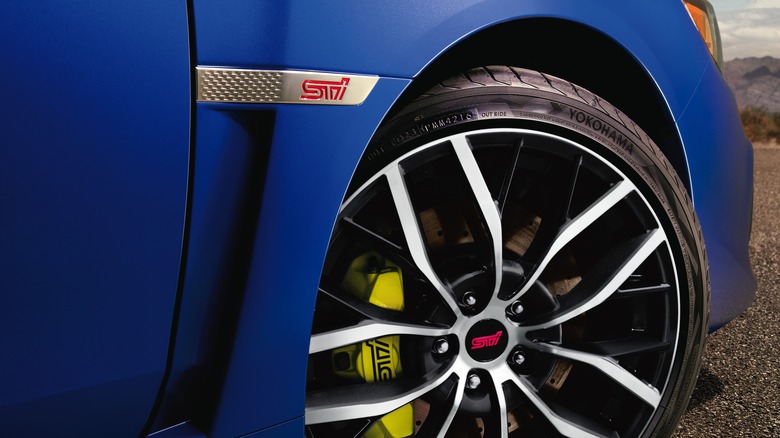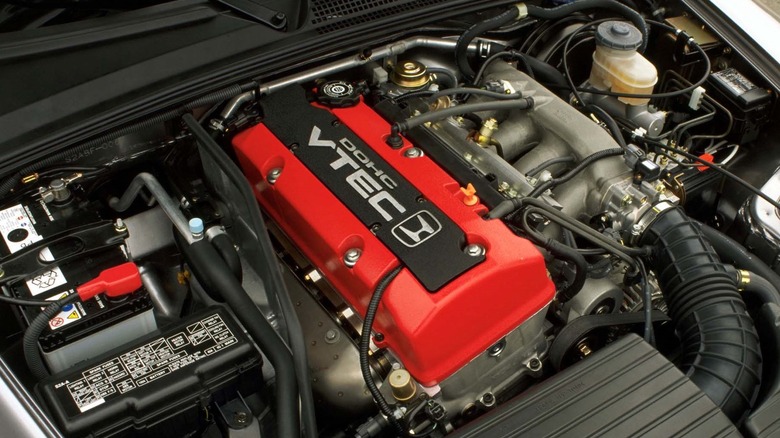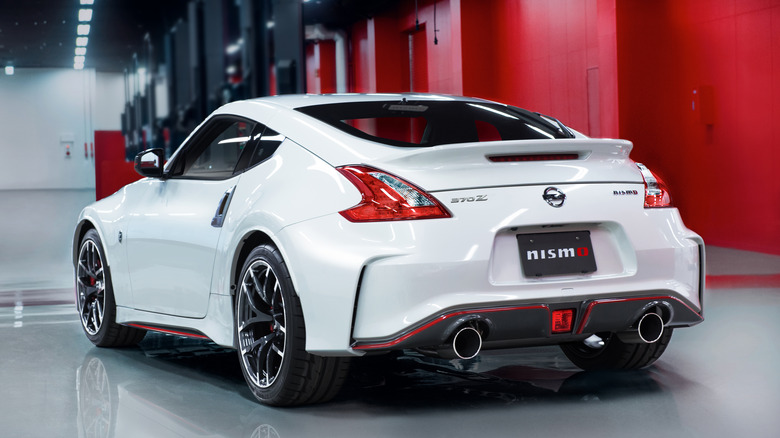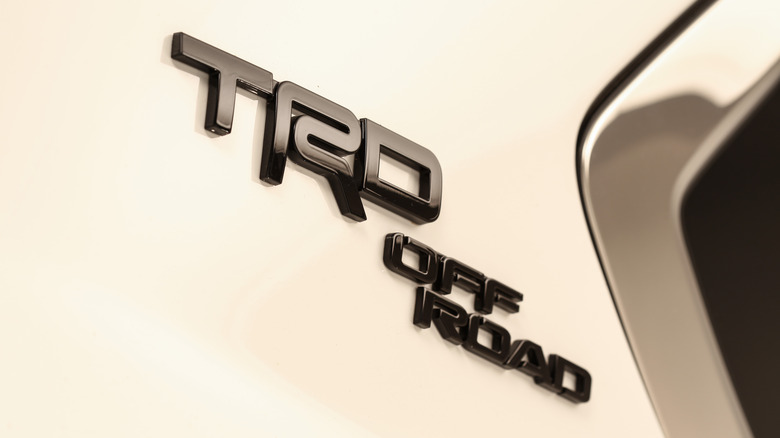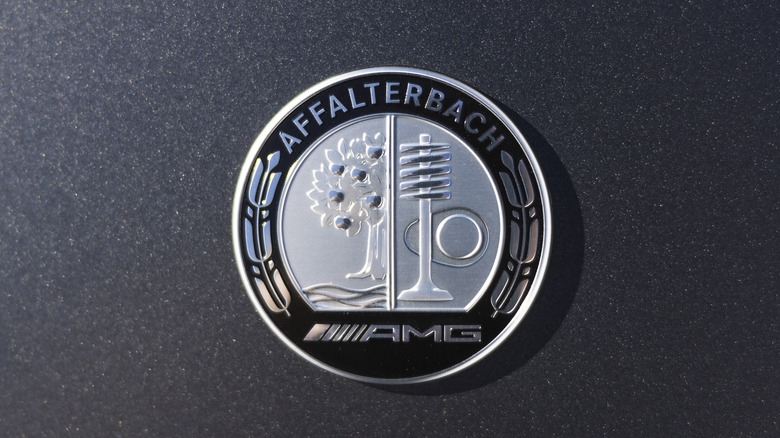Do You Know The Meaning Of These 5 Famous Car Badges?
When you look at a car and see the word "TURBO" on it in giant font, that doesn't leave too much to the imagination. It's very obviously turbocharged. The same can be said with badges on some Chrysler cars that say "HEMI." That means the car is equipped with a Chrysler HEMI engine.
Sometimes, however, there are badges and titles on a car that aren't quite as easy to parse. Occasionally they denote a special feature or performance mod that makes the car a little different than your average grocery store lot fare. Sometimes it's just because the car has a spoiler and body kit that's ever so slightly altered from the base model. Either way, the car itself isn't always forthcoming about what exactly its badges and acronyms mean. Fortunately, with a little bit of digging into automotive history and looking at how a specific brand presents its cars, it's not all too daunting to decipher.
Subaru STi
Subarus with a huge "STi" badge can take on a few flavors depending on where you see one. These cars are equally at home ripping through back roads during an international rally competition or revving loudly in a parking garage at 4am. There doesn't seem to be a lot of middle ground. But what exactly does the badge mean aside from "fast Subaru?" It's actually an acronym for "Subaru Technica International" and denotes the performance division of Subaru that's been making rally cars since 1988.
Subaru's current lineup is sadly lacking in STi cars, but past models have been nothing short of howling all-wheel drive turbocharged rally monstrosities like the WRX STi. The most recent WRX STi sported 310 hp, Brembo brakes clad in all manner of wacky colors and Apple CarPlay integration so you can listen to speed metal to your heart's content while whipping around the rally course or abandoned parking lot of your choice.
Honda VTEC
Looking at performance Honda, you will likely see the word "VTEC." It's not mechanical magic or some performance feature exclusive to Honda. It's also an acronym. In this case, it's Honda's branded and catchy name for Variable Valve Timing and Lift Electronic Control — a technology that's present on many modern cars. Instead of printing that mouthful on an engine cover or a vinyl decal, Honda decided that simply "VTEC" got the point across.
According to Honda, early VTEC technology was used to get around horsepower limitations on small engines without having to resort to expensive options like turbocharging or just making the engine bigger. Honda was able to tweak the timing of the engine's valves and lift mechanisms to extract a bit more power from the engine. It's part of the reason why the Honda S2000's 2-liter engine can rev to 9,000 rom and makes 240 horsepower. Commercially, VTEC has been around since 1989 and has been utilized in just about every consumer level Honda since then, with or without turbocharging.
Nissan NISMO
Any fans of Nissan are likely familiar with the word "NISMO." To some cars, like the 370Z, the NISMO treatment adds aggressive trim and gives the car an intimidating race-ready presence. For other cars, like the Nissan Juke, it looks like the car fell into a box of model airplane parts. In the Japanese market, even the Nissan Serena van is available with a NISMO body kit. Like many automotive terms, NISMO is a condensed word that stands for "Nissan Motorsports."
Nissan has a lengthy motorsports history, and it would be a disservice to fans of the brand to not include at least a nod to its racing pedigree in its commercial lineup. Nissan notes that all NISMO models are mostly built on the factory line like your average Altima, but all the NISMO-specific touches like paint, interior work, and aerodynamic components are hand applied and individually inspected by engineers prior to ever seeing a customer.
Toyota TRD
Toyota's current TRD lineup consists of the Camry, Tacoma TRD PRO. Tundra TRD PRO, 4Runner TRD PRO, Sequoia TRD PRO and RAV4 TRD. TRD stands for "Toyota Racing Development" and the "Pro" line carries a bit of that racing panache, but is more offroad focused. TRD also serves as Toyota's performance parts division.
A TRD Camry, for example, has a factory spoiler, a 301 hp 3.5 litre V6, and a host of aerodynamic and suspension upgrades. The Camry isn't generally synonymous with "sporty," but the TRD Camry absolutely fits the bill. A TRD Pro Tacoma gets a cornucopia of off-road parts and aesthetic upgrades, not the least of which is the giant "TOYOTA" badge across the front grille, in case anyone forgets what kind of truck you drive. Skid plates, FOX-brand shocks, a new exhaust, and a locking rear-differential are nice too. All told TRD cars are just a bit "extra" compared to a base model Toyota.
Mercedes-AMG
Mercedes-AMG cars, especially the sedans and coupes, are essentially muscle cars with a doctorate. AMGs have all the power and speed of American muscle cars like a Dodge Challenger, but are notably more understated in appearance, and sometimes, only the AMG badge betrays the fact that the station wagon sitting next to you in traffic has a biturbo V8 that produces north of 600 horsepower, as is the case with the AMG E-Class Estate.
The AMG moniker derives from the names of the two men that started it, Hans Werner Aufrecht and Erhard Melcher, and Großaspach, Germany, the former name of the village where Aufrecht lived. Together, it's Aufrecht, Melcher, Großaspach, or AMG. The company initially started as an independent tuning house for Mercedes racing engines but was later acquired by DaimlerChrysler. AMG still maintains a separate factory process in Affalterbach, Germany, and cars like the Mercedes-AMG GT series are creations entirely by the AMG team and have no mainline Mercedes-Benz counterpart.
